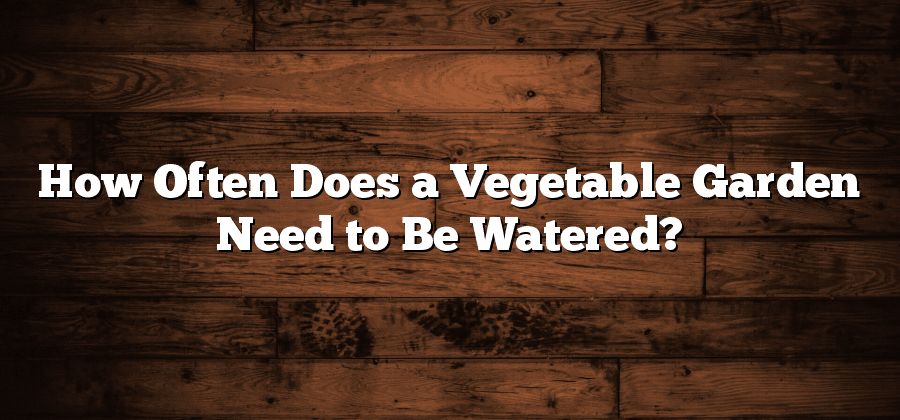Factors Affecting Watering Frequency in Vegetable Gardens
One of the key factors that determines the watering frequency in vegetable gardens is the type of soil. Different soil types have different water holding capacities, which affects how often water needs to be applied to keep the plants adequately hydrated. Sandy soils tend to drain water quickly and require more frequent watering, while clayey soils hold water for longer periods and may need less frequent watering.
Another factor to consider is the weather conditions. Hot and dry climates, for example, will result in faster evaporation of water from the soil, leading to increased watering needs. Similarly, windy conditions can also contribute to increased water loss, requiring more frequent watering to compensate for the moisture loss. On the other hand, cooler and more humid climates may require less frequent watering as the soil retains moisture for longer durations.
Understanding the Water Needs of Different Vegetable Plants
Vegetable plants, just like any other living organisms, have specific water needs that must be met for optimum growth and production. Understanding the water requirements of different vegetable plants is essential for gardeners and farmers to ensure their plants receive adequate hydration without over or under watering.
Each vegetable plant has unique water needs determined by various factors such as their stage of growth, environmental conditions, and the type of soil they are planted in. For instance, leafy greens like lettuce and spinach require frequent watering to keep their shallow root systems moist, while root vegetables such as carrots and radishes need less water as they grow deeper into the soil. Other factors that influence water needs include temperature, humidity, and rainfall patterns. By observing and monitoring these factors, gardeners can determine the appropriate amount of water to deliver to each vegetable plant, promoting healthy growth and optimal yields.
Understanding the water requirements of different vegetable plants is a fundamental aspect of successful gardening. With this knowledge in hand, gardeners can tailor their watering schedules and techniques to cater to the specific needs of their plants. By providing the right amount of water at the right time, vegetable gardeners can ensure thriving plants that yield a bountiful harvest.
Assessing Soil Moisture Levels to Determine Watering Frequency
Soil moisture levels play a crucial role in determining the frequency at which vegetable gardens need to be watered. By assessing the moisture levels in the soil, gardeners can ensure that their plants receive the appropriate amount of water for optimal growth and health.
To assess soil moisture levels, there are several techniques that can be employed. One common method is the finger test, where a gardener inserts their finger into the soil up to the second knuckle. If the soil feels dry at that depth, it is an indication that watering is needed. Alternatively, a moisture meter can be used to provide a more accurate reading of the soil moisture content. This device measures the electrical conductivity of the soil, which is directly related to its moisture level. By regularly assessing soil moisture levels, gardeners can adjust watering frequency accordingly and avoid both overwatering and underwatering their vegetable plants.
The Importance of Proper Drainage in Vegetable Gardens
Proper drainage in vegetable gardens plays a crucial role in the health and productivity of your plants. When it comes to gardening, water is essential, but it is equally important to ensure that excess water can drain away effectively. This is because waterlogged soil can lead to a plethora of issues, such as root rot and fungal diseases, which can ultimately result in the death of your plants.
Having good drainage in your vegetable garden is particularly crucial for plants that prefer drier conditions, such as tomatoes and peppers. These plants are susceptible to root diseases if their roots are constantly sitting in soggy soil. By ensuring that your garden has proper drainage through techniques like raised beds or well-amended soil, you can create an environment that allows water to penetrate the roots while excess water flows away, promoting healthy root development and overall plant vigor.
Watering Techniques for Maximizing Plant Health and Yield
When it comes to watering techniques for maximizing plant health and yield in vegetable gardens, there are several key factors to consider. First and foremost, it is important to establish a consistent watering schedule. This means providing the necessary moisture regularly and in the right quantities, rather than sporadically. By doing so, you can ensure that the plants receive the hydration they need to thrive, without overwhelming them or causing water stress.
Another crucial aspect to consider is the method of watering. While overhead sprinklers may be convenient, they can lead to excessive water loss due to evaporation. Furthermore, they can contribute to the spread of diseases by creating moist conditions on the foliage. Instead, using methods such as drip irrigation or soaker hoses can be more effective. These allow the water to be delivered closer to the roots, minimizing wastage and promoting efficient absorption. Additionally, mulching around the plants can help reduce evaporation and maintain soil moisture, further enhancing the watering technique for optimal plant growth and yield.






